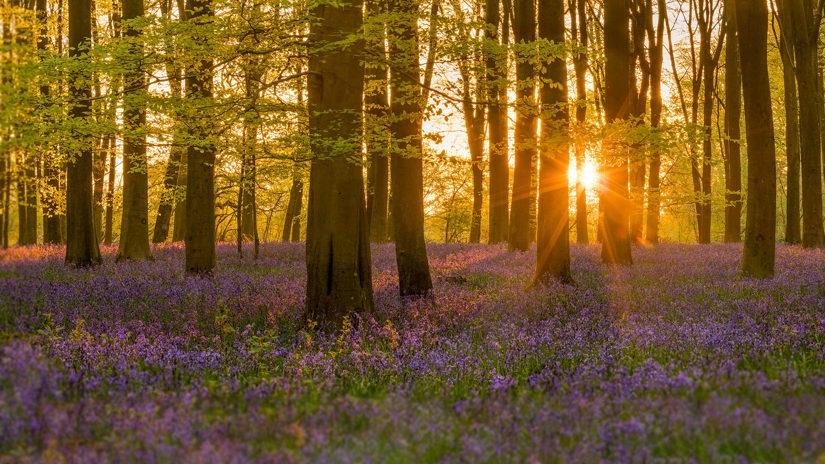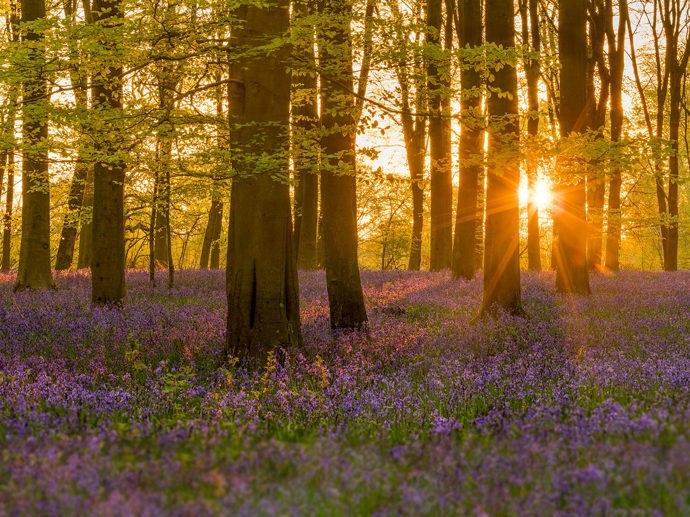

Get your nature therapy
We look after more than a thousand woods across the UK. They're open and free for you to explore.

Senior PR officer
The sights, sounds and smells of life in a British woodland have been proven to fill us with joy and boost our wellbeing, groundbreaking new research has revealed.
An overwhelming 90% of more than 10,000 questioned for a study supported by the Woodland Trust said their mood and general wellbeing were boosted by the wildlife in the UK’s precious woodland.
The research identified specific mood-lifting traits found in woods – from spotting a squirrel scurrying up a trunk and hearing a robin’s early-morning song, to witnessing a bird of prey soaring in the sky or feeling the crunch of autumn leaves underfoot.
But worryingly, the research pinpointed huge regional differences, with the majority of wellbeing hotspots found in the South East and parts of Scotland – areas with a higher proportion of woodland, especially ancient and long-established woodland cover.

These locations are rich in the variety of woodland plants, animals and fungi which people reported as being beneficial for their wellbeing, but previous studies have shown that only 7% of Great Britain’s woods are in good ecological condition.
The extensive BIO-WELL research was carried out by scientists at the University of Kent, with the latest research financed by a grant from the UK’s largest woodland conservation charity, the Woodland Trust.
Zoe Davies, Professor of biodiversity conservation at the University of Kent’s Durrell Institute of Conservation and Ecology (DICE), said:
"While we know that spending time in natural environments can improve our health and wellbeing, we needed to know which species, or traits of species delivered these benefits.
"This compelling new research proves that nature is good for us and spending time in biodiverse, rich woodland can be a prescription for wellbeing."
Key findings include:
Surprisingly, the research found that seasonal differences were irrelevant to the mental health benefits, meaning that, while humans may yearn for sunnier and warmer spring days after a long, bleak winter, a walk in the woods is beneficial in any weather and at any time of year.
Woodland Trust chief executive Dr Darren Moorcroft said:
"The Woodland Trust is evidence based. Research like the BIO-WELL findings that we have supported is not only fascinating but vital to underpin what we do as the UK’s largest woodland conservation charity, for nature and people.
"We're in the grip of a biodiversity and human health crisis, so it has never been more critical to improve the health of people and the planet. Proving that it’s good for us to get out among trees and nature means the next step must be ensuring that everyone in the UK has access to vibrant, nature-rich woodland where wildlife – and people and communities – can thrive."
Martin Dallimer, Professor of environmental sustainability at Imperial College London, agreed:
"If we want people’s wellbeing to improve from spending time in nature, then it is essential to make sure we are maintaining and restoring high-quality forests for wildlife and people."

Maps produced by the researchers showed strong regional disparity in woodland quality for wellbeing, highlighting the importance of restoring woodland biodiversity – especially in those areas which need it most.
Woodland Trust conservation adviser Sally Bavin explained:
"This work shows there is stark geographical inequality across the UK in the opportunity for people to witness thriving woodland wildlife and experience the wellbeing lift that brings. This opportunity should be the right of all.
"The research’s focus on the distribution of woodland quality really fits with the Woodland Trust’s mission to improve the quality of woodlands rather than just the quantity. The research maps will allow us to target conservation efforts where they are needed most."
Dr Jessica Fisher, research fellow at DICE, said the regional findings were 'concerning'. She added:
"The research suggests visiting a woodland rich in the variety of wildlife that supports human wellbeing is a privilege unequally distributed across society, and furthest from reach for those who could potentially benefit the most.
"Society needs a much better balance of woodland to ensure we can all access the traits that are going to boost our mental health."
The research drilled down to discover which species were most enjoyed for their wellbeing benefits, including the top 10 favourite trees, other plants, animals and fungi. The top 10 trees were:


We look after more than a thousand woods across the UK. They're open and free for you to explore.
For more information please contact Owen Phillips at owenphillips@woodlandtrust.org.uk, or call the Woodland Trust press office on 01476 602993.
The Woodland Trust is the largest woodland conservation charity in the UK with more than 500,000 supporters.
With a vision of a world where woods and trees thrive for people and nature, today the Trust owns and cares for more than 1,000 woodland sites, covering around 33,000 hectares.
The Woodland Trust has three key aims:
Access to all Woodland Trust woods is free so everyone can experience the physical and mental benefits of trees.
Established in 2016, the Woodland Trust's conservation research programme delivers applied research through funding and collaboration.
This research was funded by the European Research Council (ERC) under the European Union’s Horizon 2020 research and innovation program (Consolidator Grant No. 726104), and the Woodland Trust. Prof Zoe Davies (Durrell Institute of Conservation and Ecology, University of Kent) led the ERC project, with support from Dr Jessica Fisher and Dr Gail Austen (DICE, University of Kent), Prof Martin Dallimer (Imperial College London), Prof Robert Fish (Imperial College London) and Dr Katherine Irvine (James Hutton Institute).
The previous research by Kent University which underpinned the foundations for the new project can be explored via:
Mental ill health is one of the greatest challenges facing healthcare in Europe, affecting 13% of the population (World Health Organisation, 2022), and mental health problems cost the UK economy at least £117.9 billion per year (McDaid et al., 2022). The prevalence of mental health disorders such as anxiety and depression are increasing (McManus et al. 2016).